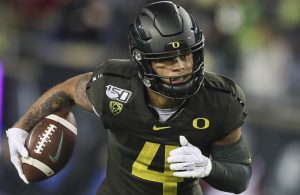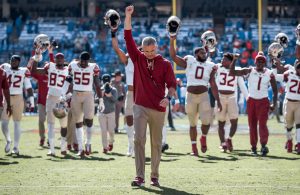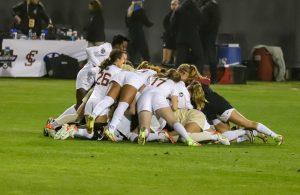- Sunday Seminole Summary: FSU Football Adds Pair of WR Transfers
- Sunday Seminole Summary: FSU Football Exits ESD With Top-15 Class
- Sunday Seminole Summary: FSU Soccer Tops BYU for Third National Championship
- Sunday Seminole Summary: FSU Soccer Advances to National Championship Match
- Seminole Sunday Summary: FSU Soccer Heads Back to College Cup
- Seminole Sunday Summary: FSU Soccer Reaches Sweet 16; Football Tops Boston College
- Seminole Sunday Summary: FSU Soccer Wins ACC, Advances to Second Round of NCAA Tournament; FSU Football Rallies Past Miami
- Seminole Sunday Summary: FSU Soccer Tops Wake on OT to Advance to ACC Final
- Seminole Sunday Summary: FSU Football Crushes UMass for Third Straight Win
- Seminole Sunday Summary: FSU Soccer Stays Perfect with Pair of Wins
FSU’s 1993 National Title Team’s Silver Anniversary — Part XII: Reflections 25 Years Later
 Rick Stewart/Getty Images
Rick Stewart/Getty ImagesIt’s been 25 years since Florida State claimed its first national championship. The 1993 team delivered FSU college football’s ultimate prize for the first time. In a multi-part series commemorating the silver anniversary of Florida State’s first title team, we finish remembering that season with five former players who played a prominent role in the team’s success.
Florida State’s 18-16 victory over Nebraska in the Orange Bowl on Jan. 1, 1994 had the Seminoles feeling pretty good about themselves, but a national championship was not quite a sure thing just yet. Entering bowl play, the Seminoles topped the AP Poll, but were third in the Coaches Poll behind Nebraska and West Virginia.
FSU would get help from an unlikely source as arch-rival Florida blasted the Mountaineers in the Sugar Bowl, 41-7. Notre Dame, who had defeated FSU during the regular season, entered the Cotton Bowl ranked fourth before holding off Texas A&M, 24-21.
There was some thought that the Fighting Irish could claim the title by virtue of their head-to-head win over the Seminoles. When the final polls were released on Jan. 3, the Seminoles had earned 46 of 62 first-place votes in the AP Poll and 36 in the Coaches Poll to become outright national champions for the first time.
“It was a pretty magical moment,” said Todd Rebol, a sophomore linebacker in 1993. “It’s absolutely special. Once you have gone through it and seen what it takes to be national champions, it’s pretty powerful when you look back at what it takes to get to be in that position. One little play or one little mistake can change everything.”
The 1993 season for Florida State was full of magical moments from the early-season goal line stands to snapping the losing streak to Miami to having the title decided by means that had been unkind to FSU in the past — on a kick. FSU had lost to Miami in each of the prior two seasons on missed field goals only to see its first title come on a Florida State make on one end and a Nebraska miss on the other.
“It’s funny to me that we always talk about these kicks,” said Kez McCorvey, the team’s leading receiver in 1993. “When you’re a player, you see all the other things outside the kick. I saw us not scoring touchdowns. It culminates with the kick, but that’s not really the reason why.”
Prior to the 1993 season, Florida State had a handful of years when it came close to claiming a national title, only to fall short. For the Shiver family, that agony didn’t begin with Clay, the starting center on the national championship team. Shiver’s brother, Stan Shiver, played safety at FSU from 1984-88 and was a starter on the 1987 team that suffered just one loss to Miami, 26-25, on a missed 2-point conversion as time expired.
“Year after year, I watched it happen,” Clay Shiver said. “It was hard to even party after the Nebraska game, because it was such a relief. I watched it happen with my brother. You’re thankful for the championship and when I look back, I’m thankful for the ride.”
When it comes to field goal kicking, Shiver noted that since Scott Bentley’s make, it has been an area where the Seminoles have excelled. FSU has four Lou Groza Awards, which is twice as many as any other school and currently has four kickers on NFL rosters.
“It was almost like there was a curse that was broken when Scott split those uprights,” Shiver said. “Look at the success of Florida State kickers after that. It’s kind of cool to see things unfold that way.”
“It was even more poetic justice that it happened in the Orange Bowl,” said Derrick Brooks, an All-American junior linebacker in 1993. “There had been so many heartbreaking moments there before that.”
Clifton Abraham, a starting cornerback in 1993, said that year ended a lot of stigmas about Florida State and head coach Bobby Bowden not being able to win a national championship. Prior to FSU quarterback Charlie Ward, the 1993 Heisman Trophy winner and school’s first, leading the Seminoles down the field on the winning drive, Heisman winners had just one bowl win in the previous nine years.
“There was this thing about the Heisman Trophy winner not winning the bowl game,” Abraham said. “There was always this thing about Coach Bowden not winning a national championship. There’s just something special about being the first.”
Several players said finally capturing the national championship changed the perception of the program.
“We came to be on the same level as Michigan, Notre Dame and Miami with their traditions,” Abraham said. “We caught up that year. When I got there, we weren’t the same Florida State program as when I left. We went from the small guy to the blue blood. We became a national brand.”
Entering the 1993 season, FSU had finished in the top 5 in six straight seasons, but had been unable to seal the deal on a national championship. Rebol and McCorvey acknowledged that while players on those teams and FSU teams before them weren’t all on the roster in 1993, they too were responsible for bringing the first title to Tallahassee.
“If we didn’t have 10 years or so of great football before us, we might not have been able to recruit the type of player to be in that situation,” Rebol said. “I don’t know if it’s more special to be part of the first or just to win it. From mat drills to coaches breaking down the little things on film, there’s so much that goes into this that makes it absolutely special.”
“I think we helped to start the next phase,” McCorvey said. “Programs take steps. There were guys before us who helped get us to that point. We took Florida State from being a great team to a national championship team. We set the standard for the next phase of great teams.”
As for the Nebraska team that Florida State defeated for college football’s ultimate prize, that would be its only loss over a 3-year span. The Cornhuskers would win national championships in each of the next two seasons and three of the next four. The 1995 Nebraska team was one of the more dominant programs of the modern era, winning every contest by at least 14 points and destroying Florida in the Fiesta Bowl, 62-24.
“We were kind of to them what Miami had been to us in the years before,” Rebol said. “We got them at just the right time before they figured it all out the next year. I don’t know that the Dallas Cowboys could have beat that ’95 Nebraska team.”
Following the 1993 season, FSU would finish in the top 5 in each of the next seven seasons and play for four national championships. The Seminoles managed to win only one, but that was Bowden’s first and only perfect season in 1999. Florida State would win a third national championship in 2013 under successor Jimbo Fisher.
“There’s something to being the first and setting that standard,” Brooks said. “It’s excellent to have been part of the group that got Coach Bowden his first championship. Everything since then has been built on that foundation. We’ve won two since and we certainly hope Coach (Willie) Taggart can build on that standard.”
Mike Ferguson is the editor of The Daily Nole. Follow Mike on Twitter @MikeWFerguson
Related Posts
One Comment
You must be logged in to post a comment Login
Leave a Reply
Cancel reply
You must be logged in to post a comment.
About Mike Ferguson
Mike Ferguson is the editor of The Daily Nole and former editor of Noled Out. Mike has more than seven years experience as a sports writer including the last four in print and online media. Mike graduated from Florida State University in 2009 with a Bachelors in Religion and a minor in Communications. Mike provided press coverage of Florida State's run to the 2013 BCS National Championship. Mike is also a news reporter at Polk County's newspaper, The Ledger in Lakeland, Florida. and contributes to Athlon Sports and ACCSports.com. Mike has been featured on sites as prominent as Yahoo Sports, FoxSports.com, Associated Press and the front page of SI.com while interviewing athletes as high profile as 2013 National League MVP, Andrew McCutchen. Email Mike at Mike@TheDailyNole.com. Follow Mike on Twitter @MikeWFerguson.




Pingback: Remembering Bobby Bowden: A Compilation From Former Players — Part III - Fifth Quarter